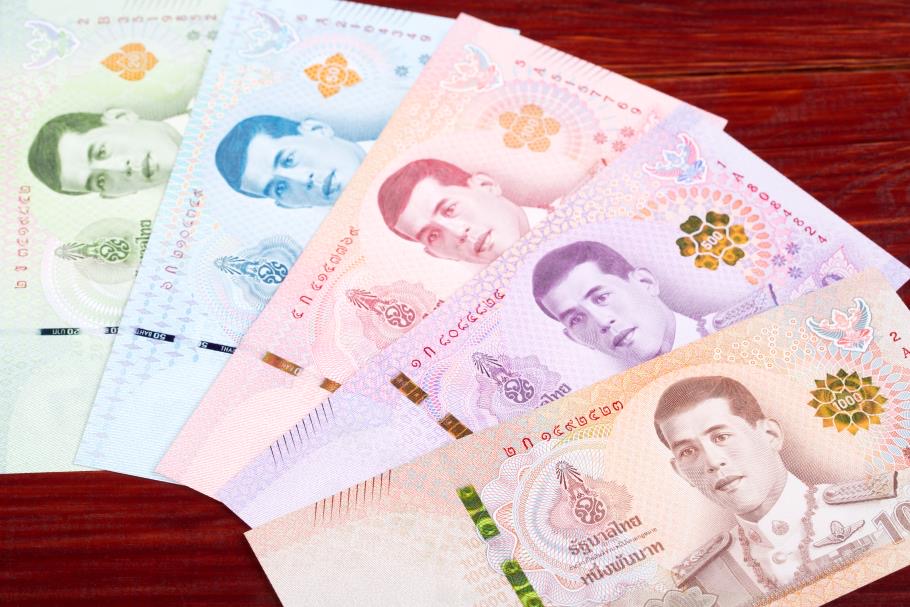General Information About Thailand’s Economy
Thailand’s economy is well-known for its tourism activity, which made up 18% of total GDP in 2022 as a result of 11.5 million tourists visiting the country. Prior to COVID-19 in 2019, this number reached a much higher peak as the Southeast Asian nation hosted about 40 million tourists. It was on a steady upward trajectory since 2010, starting at 15.5 million and growing by an average of 2.66 million tourists per year.
While Thailand’s tourism numbers are strong, its economy is even more reliant on exports, which accounted for 58% of GDP in 2021. A large portion of these exports are related to computers, office machinery, vehicles and vehicle parts, and some natural resources such as rubber, gems, seafood, and rice. Its largest trade partners are the USA, China, and Japan.
The Land of Smiles is currently the second largest economy of all ASEAN (Association of Southeast Asian Nations) countries, with only Indonesia in front of it. Thailand is highly competitive globally too, with its economy ranking 30th overall by nominal GDP. Using Purchasing Power Parity, Thailand is ranked 23rd.
This has led to a reputation for dependability not only within the Southeast Asian region, but around the world.
2024 Thai Economy and Monetary Conditions by the Numbers
The Thai economy is expected to grow from 2.5-3% in 2024 according to Bank of Thailand (BOT) projections compared to growth of 2.5% in 2023. When you factor in the proposed digital wallet program, 2024 GDP could grow even further to 3.8% as reported by the World Bank.
The BOT is carefully managing stable monetary conditions in the country, and on February 7th, 2024 the Monetary Policy Committee voted to maintain the current policy interest rate of 2.5%. This was done because of recently slowed export and tourism income that’s expected to impact part of 2024.
Because of the BOT’s policy, commercial banks in Thailand will continue to lend at relatively high interest rates while inflation is expected to be about 2% in 2024 and 1.9% in 2025. Maintaining the policy rate also led to lowered GDP projections from an initial 3.2% to the currently expected 2.5-3%
Here are some additional numbers that describe the condition of the Siam economy:
- $285 billion USD in exports in 2021. That year there was a trade surplus of $33 billion.
- Trade between Thailand and the USA in 2018 was $44.5 billion total, with $31.9 billion of that being Thai exports.
- In 2021 Thai exports to the United States grew to $45.3 billion. Exports to China and Japan that year were $37.7 billion, and $25.1 billion respectively.
- Thailand’s top import is crude petroleum, totaling $20.1 billion in 2021.
- The second largest import was integrated circuits, used in their machinery production industry. These totaled $11.3 billion in 2021.
Strengths and Advantages of the Thai Economy
The main strength of the Thai economy is in its exports, which make up the majority of the country’s GDP. Like many of the other “tiger cub” economies of Southeast Asia, Thailand grew rapidly in the late 20th century thanks to trade, largely automotive and now also computer hard discs.
The Thai government is also investing resources on technological advancements, with its data center market expected to reach $1.4 billion USD by 2028. This has helped to attract the business of global tech giants like Google and Amazon.
Another economic advantage of Thailand is its beautiful tropical location which has attracted more and more tourists and their money over the years. That climate has also lent itself to a strong agriculture sector, helping to make the country resilient enough to push through an economic crisis in 1997 and 2008 as well as the COVID-19 pandemic.
Finally, the Thai baht has proven to be one of the greatest strengths of the Thai economy, holding steady against the US dollar better than any other developing economy. This led the financial times to declare the Baht “the world’s most resilient currency.”
Weaknesses and Defects of the Thai Economy
The main weaknesses and defects that have troubled the Thai Economy over the years are political unrest, environmental disasters, and vulnerability to economic downturns.
Thailand has suffered a large number of military coups in their history with the most recent one being in 2014. Each attempt, whether successful or not, has a negative impact on the economy.
Environmental disasters, like the Indian Ocean tsunami of 2004 ($2 billion USD) or the flooding in 2011 ($46.5 billion) take a large economic toll, too. As a low-lying coastal nation, Thailand is particularly vulnerable to these events and it may get worse with global warming, which is why the government has set ambitious goals of net-zero carbon emissions by 2065.
Finally, Thai reliance on exports makes it more vulnerable to economic shocks. This style of economy can have other negative effects, too, such as poor human well-being, low wages, and difficult exchange rates.
How Diverse Is the Thai Economy?
The Thai economy is very diverse, with its service sector making up 56%, industrial at 35%, and agriculture comprising 9% of its GDP in 2021.
Much of the industrial sector is focused on automotive and electrical manufacturing of several products such as cars, computer hard disk drives, and office machinery. Jewelry is another sub-section of the manufacturing industry with exports totaling $15.7 billion USD in 2019.
Within the service sector, Thailand has many banks, a thriving retail sector anchored by traditional markets and modern shopping malls in Bangkok, and tourism that has been a steady presence for decades.
A subcategory of that tourism industry is medical tourism which has steadily strengthened throughout the years thanks to the many renowned private hospitals in Thailand. From 2017-2021 private hospitals in the country grew profits by 7.7% yearly, with Bangkok hospitals accounting for 80% of overall private revenue. These hospitals are world famous for their hospitality, service, and attract expert medical professionals in fields like plastic surgery, oncology, internal medicine, and more.
To further expand the scope of the Thai economy, the government has put forward a “Thailand 4.0” project which aims to increase development of 21st century technologies like robotics, medical innovations, and digital industries in the Land of Smiles.
The Thai Economy Over the Last Three Decades
Over the last three decades the Thai economy went through tremendous challenges and yet showed strong growth in spite of it. This began in the early 90s with an economic boom that was a result of increased exports and foreign investment, much of which came from Japan.
In 1997, a set of factors including foreign speculation, banks taking out foreign debt backed by real estate, and the devaluation of the Thai baht set off the Asian financial crisis. Thailand wouldn’t see positive GDP growth again until 1999, brought on by strict monetary policy.
After the Asian financial crisis, the tropical nation saw steady economic growth thanks to continued exports and a growing tourism economy. This tourism boom continued past the 2008 financial crisis, growing steadily up until the coronavirus pandemic in 2020.
Coming out of the pandemic, Thailand is once again showing positive growth, with a 2023 GDP of 2.5%.
Future Growth of the Thai Economy
The Thai economy is expected to grow by 2.5-3% in 2024 and 3.8%, according to the World Bank, if you include the projected benefits of the new digital wallet system. This is up from 2.5% in 2023. In 2025, there will be an estimated 3.1% growth for the economy ranked 30th globally by GDP.
Prime minister Srettha Thavisin proposed the digital wallet system in 2023 and it was originally slated for implementation for February of 2024, though it was postponed to May. The project aims to give 10,000 baht to Thai citizens who make less than 70,000 baht per month or have less than 500,000 baht in savings. This makes up about 50 million of the country’s residents.
The money will be distributed in blockchain form via a pay app called Pao Tang and aims to further digitize payments in Thailand. Any cash received must be spent within the recipient’s electoral district six months from when it arrives on consumer products, food, or non-alcoholic drinks. The added cash flows will make up roughly 3% of GDP.
Much of the additional expected growth in 2024 is from a return to normal tourism levels as Thailand has yet to hit pre-pandemic levels of tourism income (28.2 million tourists In 2022).
One of the challenges that Thailand could potentially face in the near term involves inflationary pressure from high oil prices, as the tropical nation imports a large amount of its energy. How it deals with carbon pricing is another question mark as Thailand looks to cut greenhouse gas emissions by 30-40% by 2030 and net-zero by 2065.
Future Thai Economic Growth via Thailand 4.0 Strategy
The government plans to spur future Thai economic growth via its “Thailand 4.0” strategy which aims to transition the economy to a stronger focus on digital technology. The reason it was titled “4.0” is because the transition to an innovation-driven economy will be the 4th broad stage of historical economic transition. The first three Thai economic eras were characterized by growth in agriculture, light industries, and heavy industries.
The government is offering a new smart visa program that aims to attract skilled workers, half of which must have at least a bachelor’s degree and the other half vocational skills. The specific industries targeted by Thailand 4.0 are:
- Biofuels and biochemicals
- Digital economy
- Medicine
- Automation and robotics
- Aviation and logistics
- Agriculture and biotechnology
- Smart electronics
- Affluent medical wellness and tourism
- Next-generation automotives
- Food for the future
The Eastern Economic Corridor (EEC) which consists of the provinces of Chonburi, Rayong and Chachoengsao is the planned main location for this growth. The government is in the process of investing a total of $43 billion USD from 2019-2025 in infrastructure for the area, creating a third international airport, multiple highways, and railways.
Finally, the government is implementing various incentives to attract investment including facilitation of land ownership rights and corporate tax exemption for up to 13 years. Thailand 4.0 policy will also relax rules around foreign companies, allowing 100% foreign ownership, no export requirements, and no restrictions on foreign currency.
FAQs About the Thai Economy
How Strong Is the Thai Economy?
The Thai economy is very strong with the second largest GDP of all ASEAN nations, one of the lowest unemployment rates in the world at 1%, and a strong currency with low levels of inflation. From 2013 to 2022, Thailand averaged 1.2% consumer inflation which was nearly a full percentage point below the Asia-Pacific regional average of 2.1%.
What Is the Ranking of Thailand’s Economy in 2024?
The ranking of Thailand’s economy in 2024 is 30th globally by nominal GDP, based on numbers from the end of 2023. Thailand is ranked 23rd globally when using Purchasing Power Parity which reflects the cost of living.
What Was the Percentage of Economic Growth in Thailand in 2023?
The percentage of economic growth in Thailand in 2023 was 2.5%.
What Was Thailand’s GDP in 2023?
The International Monetary Fund (IMF) valued the Thai economy at $512.19 billion USD as of 2023.
What Is the Currency of Thailand?
The currency of Thailand is the Thai Baht, and each Baht is divided into 100 satang. There are four Baht coins (1, 2, 5, and 10), five bills (20, 50, 100, 500, and 1,000), and 5 satang coins (1, 5, 10, 25, and 50).

With the Thai economy bouncing back, it could be a great time to invest in real estate. Contact PropertySights Real Estate today and consult with licensed professionals who are there to help.

